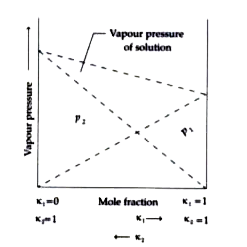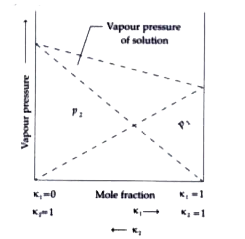Assertion (A): Henry's law and Raoult's law are not independent, i.e., one can be derived from the other.
Reason (R ): The partial pressure is directly proportional to the mole fraction of the concerned species for ideal solutions.
Both A and Rare true and R is the correct explanation of A
Both A and R are true but R is not the correct explanation of A
A is true but R is false
A is false but Ris true
The correct Answer is:A
Henry.s law and Rault. law are not indepent. They can be derived from the others.
Topper's Solved these Questions
- BOOK - EDUCART PUBLICATIONCHAPTER - SAMPLE PAPER 3EXERCISE - SECTION- C6videos
SAMPLE PAPER 3
- BOOK - EDUCART PUBLICATIONCHAPTER - SAMPLE PAPER 3EXERCISE - SECTION- C6videos
SAMPLE PAPER 3
- BOOK - EDUCART PUBLICATIONCHAPTER - SAMPLE PAPER 11 (SELF-ASSESSMENT)EXERCISE - SECTION - C4videos
SAMPLE PAPER 11 (SELF-ASSESSMENT)
- BOOK - EDUCART PUBLICATIONCHAPTER - SAMPLE PAPER 8 SOLVED (TERM-1)EXERCISE - SECTION -C6videos
SAMPLE PAPER 8 SOLVED (TERM-1)
Similar Questions
Assertion (R): At low concentration equimolar solutions of non electrolytes are isotonic and have equal osmotic pressure.
Reason (R): Osmotic pressure is directly proportional to temperature of solution.View SolutionIdentify the law which is stated as:
For any solution, the partial vapour pressure of each volatile component in the solution is directly proportional to its mole fraction.View Solution
Knowledge Check
- Question 1 - Select One
STATEMENT-1 : Henry's law and Raoult's law are not independent, i.e., one can be derived from the other
and
STATEMENT-2 : The partial pressure is directly proportional to the mole fraction of concerned species for ideal solutions.AStatement-1 is True, Statement-2 is True, Statement-2 is a correct explanation for Statement-10BStatement-1 is True, Statement-2 is True, Statement-2 is NOT a correct explanation for Statement-10CStatement-1 is True, Statement-2 is FalseDStatement-1 is False, Statement-2 is True - Question 2 - Select One
Partial pressure of a solution component is directly proportional to its mole fraction. This is known as
AHenry's lawBRaoult's lawCDistribution lawDOstwald's dilution law - Question 3 - Select One
Partial pressure of a solution component is directly proportional to its mole fraction. This statement is known as
AHenry's lawBRaoult's lawCDistribution lawDOstwald's dilution law
Assertion (A) : The vapour phase is always richer in the component which is less volatile.
Reason (R) : The relative lowering of the vapour pressure of a solution is proportional to mole fraction of the solvent.View SolutionIf Raoult's law is obeyed, the vapour pressure of the solvent in a solution is directly proportional to
View SolutionAssertion: Column's law can be derived from Gauss's law.
Reason: Gauss's law can be derived from Coulombs law.View SolutionRead the passage given below and answer the following questions :
Raoult's law states that for a solution of volatile liquids, the partial vapour pressure of each component of the solution is directly proportional to its mole fraction present in solution. Dalton's law of partial pressure states that the total pressure Ptotal over the solution phase in the container will be the sum of the partial pressures of the components of the solution and is given as:
Ptotal= P1+ P2

What type of deviation from Raoult's law does the above graph represent ?View SolutionRead the passage given below and answer the following questions :
Raoult's law states that for a solution of volatile liquids, the partial vapour pressure of each component of the solution is directly proportional to its mole fraction present in solution. Dalton's law of partial pressure states that the total pressure Ptotal over the solution phase in the container will be the sum of the partial pressures of the components of the solution and is given as:
Ptotal= P1+ P2

Which of the following aqueous solutions should have the highest boiling point ?View Solution

